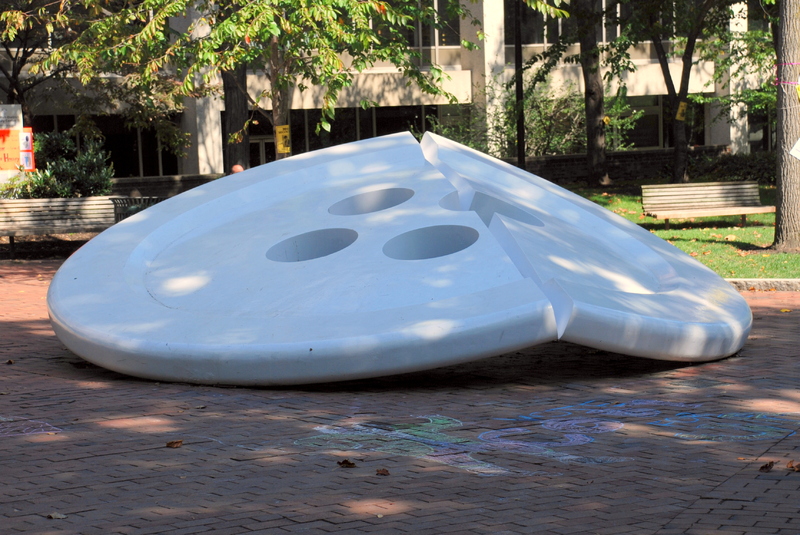Split Button
Dublin Core
Title
Description

Split Button by Claes Oldenburg, 1981
With its center location and bright and shining color, Split Button has been a landmark of the Penn campus. Everyday when students pass by it for class they can see tourist taking photo with it, classmates sitting on it, and children playing with it, getting themselves into the buttonhole. In early summer, Split Button is one of the most popular spot for graduations photos.
The Split Button was commission by the university in 1981. Of its total cost of $100,000 including transport and installation, $37,500 was from the university, $37,500 was from the National Endowment of the Arts, and the rest was provided by private contributions raised by Mrs. H. Gates Lloyd, chair of the Visual Environment Committee.
The sculptor, Claes Oldenburg, is an American artist known for his public installation of oversized everyday objects. Oldenburg was born in Stockholm and grew up in Chicago, where his father worked as the Swedish diplomat. After finishing his study at Yale, Oldenburg returned to Chicago and then moved to New York, where he was part of the Pop Art Movement. In 1963, he moved to LA and started to pay attention on imaginary outdoor monuments two years later, finishing the Lipsticks in Piccadilly Circus, London (1966). Oldenburg in 1970s focused on public commissions, with works installed both domestically and internationally. The artist also has his famous Clothespin (1976) installed in front of the City Hall of Philadelphia.

The Split Button is 16 ft. in diameter and weighs 5,000 lbs. The initial reaction of the installation was mixed. While some students and faculty found it interesting and unique, the others found it wired, served no purpose and didn’t “in the least fit with its surroundings”. Over the time, however, it has become a inseparable part of the university.

Fun facts about Split Button
- According to the legend circulated in the university, the Split Button belonged to Benjamin Franklin, a momentum located opposite to the Van Pelt Library. One day, after a whole day of feast and drinking, Benjamin sit back on his chair and one button on his vest fell off. The button rolled all the way to Van Pelt Library and stopped by a student’s shoes, split into two pieces.
- When talked about the meaning of the button, Oldenburg, the creator, said “The Split Button represents the Schuylkill. It divides the button into four parts—for William Penn's original Philadelphia squares.
- In 1990, the Split Button participated a movement in the art world in mourning the deaths in fighting AIDs and was shrouded by black drapery.
- The Split Button was shown in the episode “That 90’s Show” in The Simpsons as part of the fictional Springfield University. The writer of the episode Matthew Selman graduated from the The School of Art and Science
- The button was designed to be one piece at the beginning. Oldenburg decided to make it a split one during the production process.
